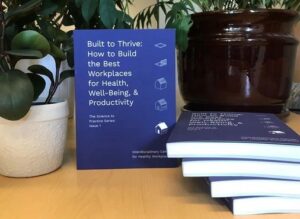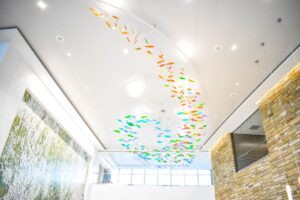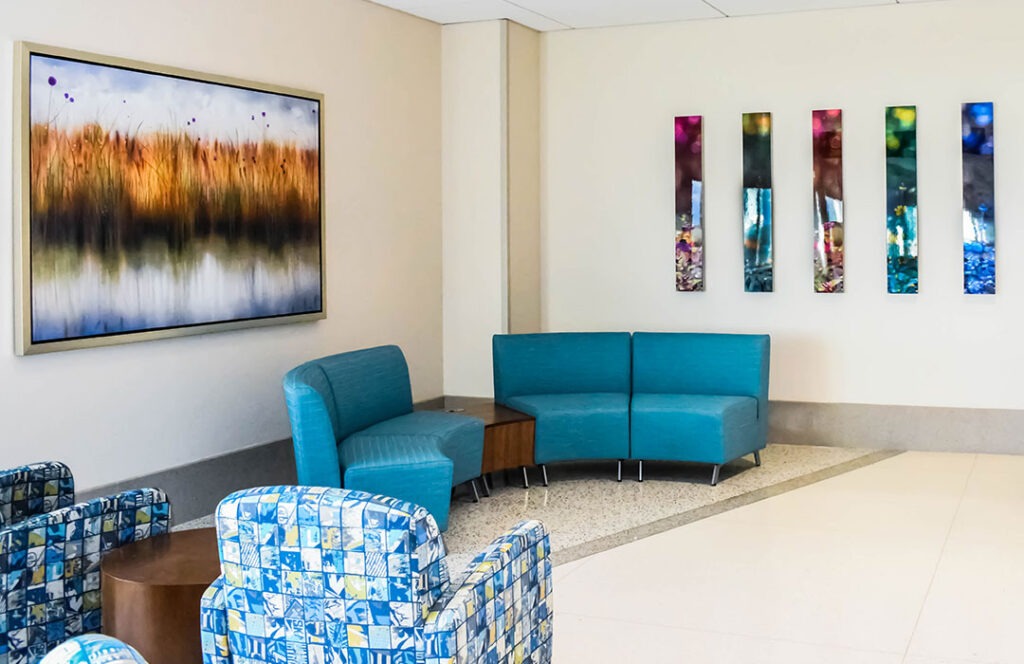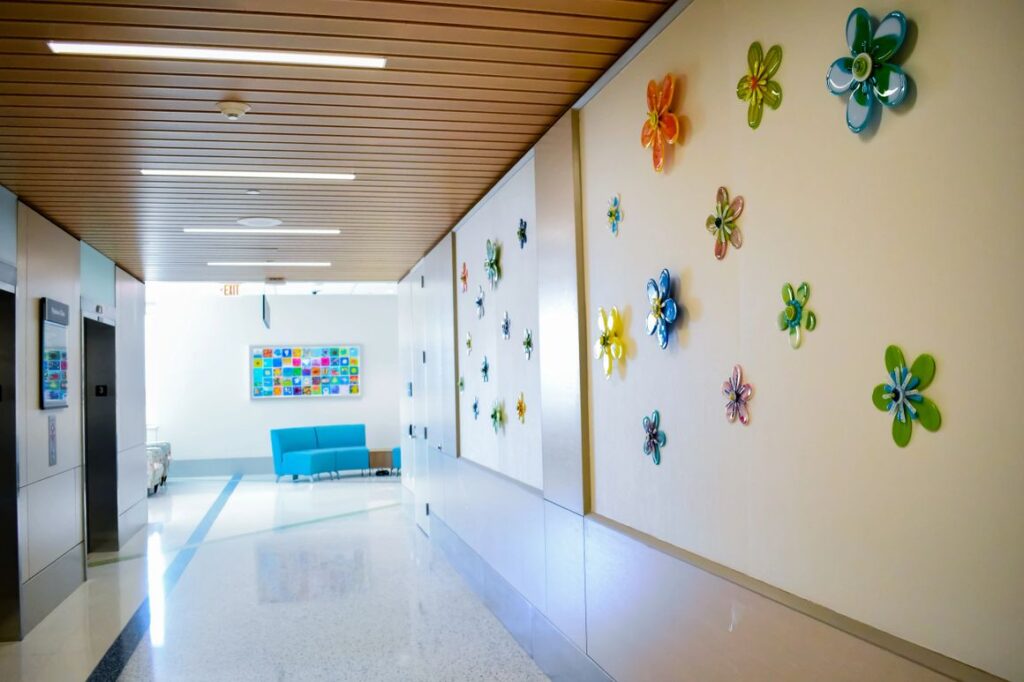
Book Recommendation for designing healthy workspaces
Book Recommendation for designing healthy workspaces
Built to Thrive: How to Build the Best Workplaces for Health, Well-Being, & Productivity
 Authors: Galen Cranz Ph.D., Gretchen Gscheidle – Design Director, Gervais Tompkin AIA, LEED AP, Anthony Ravitz LEED AP, John Swartzberg MD, FACP, Kevin Kelly RA, PCAF, Sally Augustin Ph.D., Cristina Banks Ph.D., Isabelle Thibau MPH, Caitlin DeClercq Ph.D.,
Authors: Galen Cranz Ph.D., Gretchen Gscheidle – Design Director, Gervais Tompkin AIA, LEED AP, Anthony Ravitz LEED AP, John Swartzberg MD, FACP, Kevin Kelly RA, PCAF, Sally Augustin Ph.D., Cristina Banks Ph.D., Isabelle Thibau MPH, Caitlin DeClercq Ph.D.,
This book is the product of the Interdisciplinary Center for Healthy Workplaces’ (ICHW) inaugural Science to Practice conference in 2017 titled, “How to Build the Best Workplaces for Health and Well-Being.” In the conference, we brought together experts from different disciplines and from both research and practice to attempt to address the gaps in knowledge. Here, in this book, each author provides a perspective on the design of workplaces built for health and well-being, with the different perspectives together creating the knowledge base for successful design.
Cristina Banks, Ph.D. | Director, Interdisciplinary Center for Healthy Workspaces, School of Public Health and Senior Lecturer, Haas School of Business, University of California, Berkeley Dr. Banks holds a Doctorate in Industrial-Organizational Psychology. She and Dr. Sheldon Zedeck founded the Interdisciplinary Center for Healthy Workplaces in 2012. She brings 40 years of entrepreneurial, academic, and consulting experience to the Center in leading strategy and supporting the day-to-day operations of the Center. Her consulting expertise and knowledge of work and organizations help guide Center activities toward research and practice breakthroughs that will contribute significantly to the development of healthy workplaces and the promotion of worker health, well-being, and productivity.
Isabelle Thibau, MPH | Core Researcher and Leadership Team Member, Interdisciplinary Center for Healthy Workspaces, University of California, Berkeley Isabelle Thibaut holds a Master’s in Public Health from the University of California, Berkeley. She has served in key project development and management roles within ICHW since its inception. At ICHW, she applies a public health lens to research and consulting on workplace health and well-being issues. She joined the ICHW leadership team in 2017.
Caitlin DeClercq, Ph.D. | Assistant Director, Graduate Student Services and Programs, Center for Teaching &Learning, Columbia University. Dr. DeClercq holds a Doctorate in Architecture from the University of California, Berkeley, and a Master’s of Science in Education from the University of Rochester. Caitlin worked at ICHW as a Core Researcher in 2016 and was part of the leadership team from 2017-to 2018. Her contributions to research span multiple disciplines including education, architecture, interior design, health, and sedentary work. She is a published author with articles in the Journal of Academic Librarianship and Planning for Higher Education as well as contributed chapters in Ethnography for Designers and Experiencing Architecture in the Nineteenth Century.
Gretchen Gscheidle | Design Director, Herman MillerGretchen Gscheidle holds a Master of Science degree in Product Design and Development from Northwestern University and a Bachelor of Fine Arts degree in Industrial Design from the University of Illinois at Urbana-Champaign. She led the corporate research function from 2010-to 2018 where Gretchen’s expertise ranged from product design and workplace applications to qualitative and quantitative research methods. She also led the team that researched and supported the new Living Office offering. She now leads design strategy for the firm.
Sally Augustin, Ph.D. | Principal, Design With Science, Inc. Sally Augustin holds a Doctorate in Environmental Psychology from Claremont Graduate School and a Master’s in Business Administration from Northwestern University. She is an internationally recognized design psychologist, specializing in person-centered design. Her knowledge and expertise regarding the interior design of commercial buildings and residences are applied all over the world. Among others, she wrote Place Advantage, which is considered a “classic” for interior designers.
Galen Cranz, Ph.D. | Professor Emerita, School of Architecture, University of California, Berkeley Dr. Cranz holds a Doctorate in Sociology from the University of Chicago and is a certified teacher of the Alexander Technique. She teaches social and cultural approaches to architecture and urban design in the College of Environmental Design. She has written and edited several books including The Body, the City, and the Buildings In Between and The Chair, both highly used references for body-conscious design. She introduced ethnography into design research for which she has been highly praised, including receiving the Career Award, the highest award given by the Environmental Design Research Association (EDRA).
John Swartzberg, MD, FACP | Clinical Professor Emeritus, School of Public Health, University of California, Berkeley, and Chair of the Editorial Boards, UC Berkeley Wellness Letter and Health After 50 Newsletter. Dr. Swartzberg holds an MD from the David Geffen School of Medicine at UCLA and specializes in internal medicine and infectious diseases. He teaches in the joint MD-MPH Program preparing medical students to learn about population health and prevention. He oversees the writing and publication of two highly acclaimed newsletters that have guided thousands of readers on health and wellness issues since 2001.
Kevin Kelly, RA, PCAF | Senior Architect, WorkPlace+ Project Management Office, General Services Administration, U.S. Government. Kevin Kelly holds a Master’s of Architecture from Catholic University and has worked as a Senior Architect for the General Services Administration (GSA, a government agency) in Washington, D.C. Mr. Kelly and his team developed a workplace scorecard for assessing developers of GSA properties with respect to the design quality of the building. Through Mr. Kelly’s guidance, the GSA stipulates specific features required in building contracts to ensure that quality is built into six critical areas of design: pre-design and planning, equitable workspace, health and comfort, flexibility, connectivity and mobility, reliability and sustainability, and sense of place.
Gervais Tompkin, AIA, LEED AP | Principal, Consulting Practice Area Leader, and Design Strategy Studio Director, Gensler Gervais Tompkin holds a Bachelor’s of Environmental Design from the University of Colorado at Boulder. He is a nationally recognized leader in Gensler’s Workplace Sector. Although he is based in San Francisco, his work spans the world, as he oversees global services for some of the world’s best-known tech companies. Gervais has a passion for research that has led him down a multidisciplinary path in the world of real estate strategy and design. He is driven by a desire to understand the relationship between real estate, technology, and behavior. His writing has appeared in Fast Company, IIDA Perspective, and International Design Magazine, among others.
Anthony Ravitz, LEED AP | Real Estate & Workplace Services Green Team Lead, Anthony Ravitz holds a Bachelor’s in Civil Engineering from Stanford University. He is Google’s team leader on green building as part of the Real Estate and Workplace Services team. He spearheads Google’s initiative for building healthy, eco-friendly workspaces.
Purchase the book here: https://healthyworkplaces.berkeley.edu/resources/publications/built-thrive-how-build-best-workplaces-health-well-being-productivity




 Another measure of the effectiveness of a particular selection of art is its ability to maintain interest; it is an art that doesn’t run out, doesn’t become invisible and irrelevant. Art, when appropriately selected and placed, has durability. It engages the viewers, transports them, delights and amuses them, calms and reassures them, day after day.
Another measure of the effectiveness of a particular selection of art is its ability to maintain interest; it is an art that doesn’t run out, doesn’t become invisible and irrelevant. Art, when appropriately selected and placed, has durability. It engages the viewers, transports them, delights and amuses them, calms and reassures them, day after day.